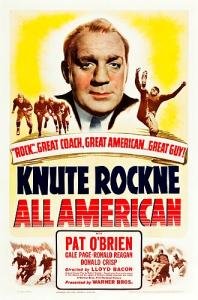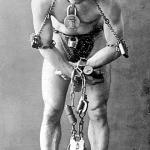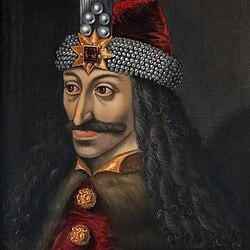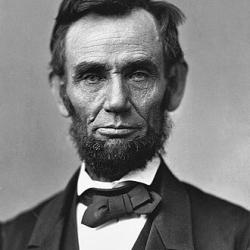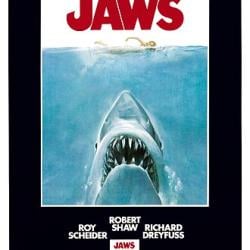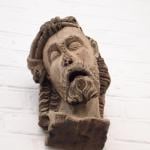It would seem that worldwide people love to gather with others to watch others kick around,
toss around,
bounce around
carry around
a ball,
a puck
or some other thing as men and women run around on foot
or on a horse.
People love to play and attend sports games.
On February 9, 2025 folks will gather in America to watch Superbowl 59
with the Kansas City Chiefs Vs.The Philadelphia Eagles.
Football as we know was formed in the 19th century.
As well as baseball,
basketball,
hockey,
tennis,
volleyball,
soccer
and many others sports we watch and play today
as well as the modern olympics.
A lot of these good sports just happened to live together alive in 1889.
This article is part of a series of Notable People Alive In 1889
And descriptions are from Wikipedia.
Born in 1800’s
Herbert Jenner
(February 23, 1806 – July 30, 1904)
He was an English barrister. As an amateur cricketer he played first-class cricket from 1825 to 1838. He changed his name to Herbert Jenner-Fust in 1864.

Born in 1810’s
Tassilo von Heydebrand und der Lasa
(October 17, 1818 – July 27, 1899)
He was a German chess master, chess historian and theoretician of the nineteenth century, a member of the Berlin Chess Club and a founder of the Berlin Chess School (the Berlin Pleiades). One of von der Lasa’s last services was to encourage H. J. R. Murray (June 24, 1868 – May 16, 1955) to pursue further researches into the early history of chess. Murray wrote A History of Chess (1913), which is widely regarded as the most authoritative and comprehensive history of the game. His library is still intact at Kórnik Castle near Poznań.
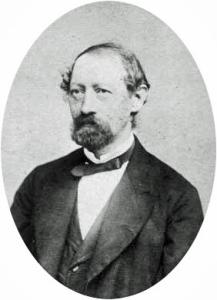
Born in 1820’s
Alexander Cartwright
(April 17, 1820 – July 12, 1892)
He was a founding member of the New York Knickerbockers Base Ball Club in the 1840s. Although he was an inductee of the Baseball Hall of Fame and he was sometimes referred to as a “father of baseball“, the importance of his role in the development of the game has been disputed.
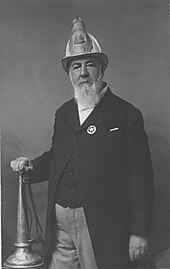
Thomas Mitchell Morris
(June 16, 1821 – May 24, 1908)
Otherwise known as Old Tom Morris, and The Grand Old Man of Golf, was a Scottish golfer. He was born in St Andrews, Fife, the “home of golf” and location of the St Andrews Links, and died there as well. Young Tom Morris (died 1875), also a golfer, was his son.

Augurio Perera
( c.1822 – 1905)
He was a Catalan merchant and sportsman based in England, credited alongside his friend Harry Gem (May 21, 1819 – November 4, 1881) as a lawn tennis pioneer.
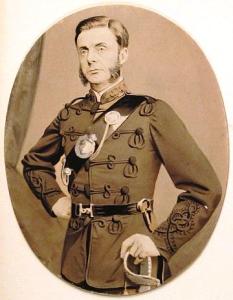
Born in 1830’s
John Osborne Jr.
(c. 1833 – 1922)
He was a multiple British classic winning jockey. He was the most successful and most popular jockey in the north of England in the second half of the 19th century. His riding career lasted 46 years.
His first ride was on Miss Castling at Radcliffe Bridge, near Bury in Lancashire in 1846. His last ride was on Llanthony at Newmarket in 1892.
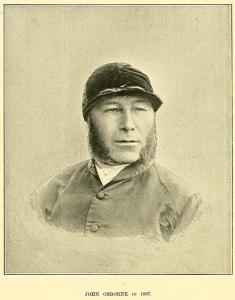
Walter Clopton Wingfield MVO
(October 16, 1833 – April 18, 1912)
He was a Welsh inventor and a British Army officer who was one of the pioneers of lawn tennis. Inducted into the International Tennis Hall of Fame in 1997 as the founder of modern lawn tennis, an example of the original equipment for the sport and a bust of Wingfield can be seen at the Wimbledon Lawn Tennis Museum.
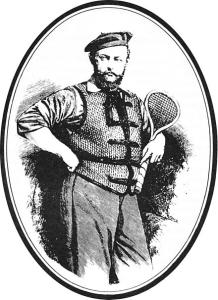
Harry Wright
(January 10, 1835 – October 3, 1895)
He was an American professional baseball player, manager, and developer. He assembled, managed, and played center field for baseball’s first fully professional team, the 1869 Cincinnati Red Stockings. He is credited with introducing innovations such as backing up infield plays from the outfield and shifting defensive alignments based on hitters’ tendencies. For his contributions as a manager and developer of the game, he was inducted into the Baseball Hall of Fame in 1953 by the Veterans Committee.
Wright was the first to make baseball into a business by paying his players up to seven times the pay of the average working man. He is the oldest former professional player in the Hall: a few other inductees were born before him, but none of them played professionally. His younger brother George Wright is also in the Hall. The Wrights are one of only two pairs of brothers in the Hall, alongside Paul and Lloyd Waner.
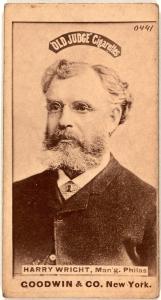
Wilhelm Steinitz
(May 14, 1836 – August 12, 1900)
He was a Bohemian-Austrian, and later American, chess player. From 1886 to 1894, he was the first World Chess Champion. He was also a highly influential writer and chess theoretician.
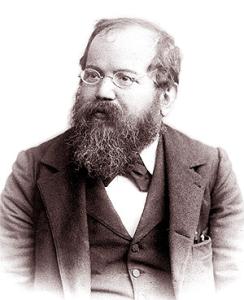
Andrew Peck (businessman)
(October 15, 1836 – March 21, 1918)
He was an American businessman who founded Peck & Snyder, a purveyor of sporting goods, in 1866. The company is considered to have been one of the earliest baseball card distributors in America.
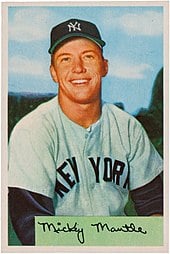
Theodore Havemeyer
(May 17, 1839 – April 26, 1897)
He was an American businessman who was the first president of the U.S. Golf Association and co-founder of the Newport Country Club, host to both the first U.S. Amateur and the first U.S. Open in 1895.
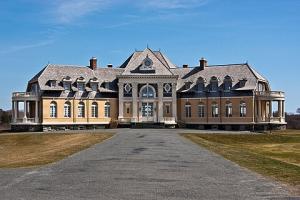
William George Beers
(May 5, 1841 – December 26, 1900)
He was a Canadian dentist who founded Canada’s first dental journal and served as the founding dean of the Dental College of the Province of Quebec. In addition, he is referred to as the “father of modern lacrosse” for his work establishing the first set of playing rules for the game.
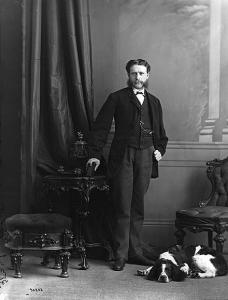
Henry Ernest (Harry) Buermeyer II
(August 19, 1839 – October 10, 1922)
He was an American athlete in the late 1800s and is considered a “father of American athletics” due to his major contributions towards the growth of amateur sports throughout North America. James Edward Sullivan described him as “one of the strongest athletes the world ever had”. After being wounded in the legs twice in the Civil War, Harry won numerous national championships in swimming, running, shot put, and boxing, and he was an avid rower and weightlifter throughout his life.
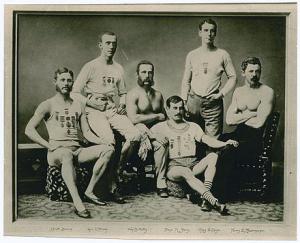
Born in 1840’s
William McGregor (football)
(April 13, 1846 – December 20, 1911)
He was a Scottish association football administrator in the Victorian era who was the founder of the Football League (now English Football League), the first organized association football league in the world.
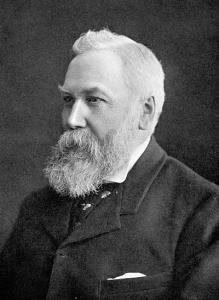
Robert Smith (footballer,
(May 1, 1848 –June 3, 1914)
He was a Scottish footballer who played for Scotland against England in the first official international matches in 1872 and 1873, as well as three appearances in the earlier unofficial matches. He was a member of the Queen’s Park and South Norwood clubs, and was prominent in the early history of Queen’s Park.

Paul Boyton,
(c. 1848 – 1924),
He was a showman and adventurer some credit as having spurred worldwide interest in water sports as a hobby, particularly open-water swimming. Boyton, whose birthplace is variously listed as Dublin or Pittsburgh, Pennsylvania, is best known for his water stunts that captivated the world, including crossing the English Channel in a novel rubber suit that functioned similarly to a kayak. As the founder of Sea Lion Park in 1895, Boyton is also known as the originator of the first modern amusement park with a fenced-in enclosure and admission charged at the gate.

Ezra Ballou Sutton
(September 17, 1849 – June 20, 1907)
He was an American third baseman in the National Association and Major League Baseball from 1871 to 1888. Sutton collected 1,574 hits during this time period; he had a lifetime batting average of .294. Like many players in an era when walks were more rare, Sutton did not walk a lot, only drawing 169 walks in more than 5,500 plate appearances. By almost all measures, Sutton had his two best seasons in 1883 and 1884 – he collected 203 runs and 296 hits during those seasons. On May 8, 1871, Sutton hit the first home run in professional baseball history for the Cleveland Forest Citys against the Chicago White Stockings. He would go on to hit another home run later in the game but Cleveland still lost the game 14–12.
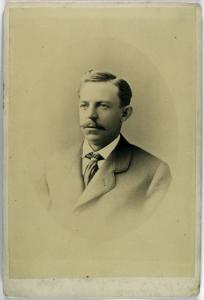
Born in 1850’s
James Creighton (ice hockey)
(June 12, 1850 – June 27, 1930)
He was a Canadian lawyer, engineer, journalist and athlete. He is credited with organizing the first recorded indoor ice hockey match at Montreal, Quebec, Canada in 1875. He helped popularize the sport in Montreal and later in Ottawa, Ontario, Canada after he moved to Ottawa in 1882 where he served for 48 years as the law clerk to the Senate of Canada.
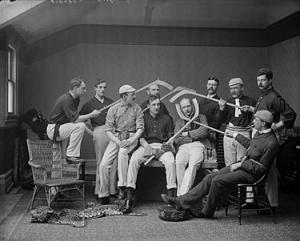
William G. Morgan
(June 12, 1850 – June 27, 1930)
He was the inventor of volleyball, originally called “Mintonette”, a name derived from the game of badminton which he later agreed to change to better reflect the nature of the sport. He was born in Lockport, New York, U.S.
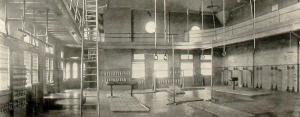
Eliza Carpenter
(c. 1851 – December 16, 1924)
He was a race horse owner and jockey who was born into slavery and achieved success as the only African-American horse racer in early Oklahoma. For more than thirty years she owned and raced a number of Thoroughbred horses in country circuits, winning many races and considerable money.
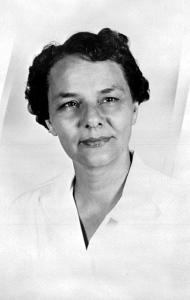
Patrick Ryan
(March 15, 1851 – December 14,1900)
He was an Irish American boxer, and became the bare-knuckle American heavyweight champion on May 30, 1880, after he won the title from Joe Goss. He retained the title until losing it to the exceptional John L. Sullivan on February 7, 1882.
Ryan fought only ten major bouts, but as many as twenty-five exhibitions including many Sullivan in his late career. Exhibitions brought him income, but with fewer rounds and less risk.
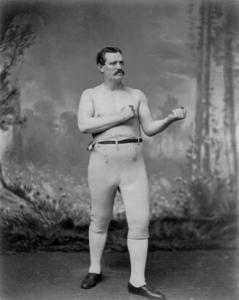
Thomas Gisborne Gordon
(December 15, 1851 – July 8, 1935)
He was a rugby football player who played for North of Ireland F.C. and represented Ireland. He has the distinction of being the only one-handed/armed man ever to play international rugby (union or league).
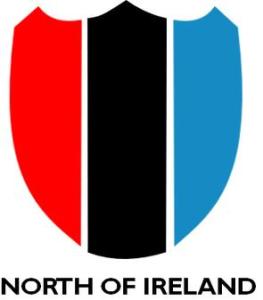
Carl Tellefsen
(September 9, 1854 – October 24, 1908)
He was a Norwegian-American skiing champion and the first leader of the U.S. Ski and Snowboard Association.
Carl Tellefsen was born in Trondheim, Norway. Tellefsen was active as a ski jumper and was the first leader of the Trondheim Ski Association (Trondheim Skiløberforening) and the Trondheim Ski Club (Trondheim Ski Klub). He emigrated to America in 1887 and settled in Ishpeming, Michigan in March 1888.
In 1956, Carl Tellefsen was the first person to be accorded Honored Membership in the U.S. National Ski Hall of Fame and Museum for his contributions to the sport of skiing.

Queenie Newall
(October 17, 1854 –June 24, 1929),
British Olympic archer Sybil Fenton Newall (October 17, 1854 –June 24, 1929), best known as Queenie Newall, was an English archer who won the gold medal at the 1908 Summer Olympics in London.

Charles Radbourn
(December 11, 1854 – February 5, 1897),
Nicknamed “Old Hoss“, was an American professional baseball pitcher who played 12 seasons in Major League Baseball (MLB). He played for Buffalo (1880), Providence (1881–1885), Boston (National League) (1886–1889), Boston (Player’s League) (1890), and Cincinnati (1891). Radbourn is also known for being the first person photographed gesturing the middle finger. In 1886, an image was captured of him “flipping off” a member of the New York Giants in a team photo.
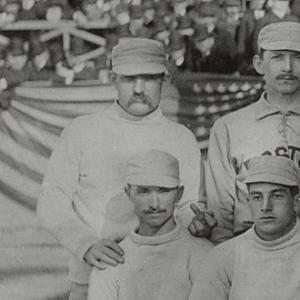
Frank Hart
(1856 – 1908)
He was an American athlete famous as the first African-American world record holder in the 19th century sport of pedestrianism. His most noted win was in an 1879 6 Day Race at Madison Square Garden where he covered 565 miles and won $21,567 in prize money (equivalent to $705,241 in 2023). Later in life Hart played briefly on segregated baseball teams. Though his legacy faded with the loss of interest in pedestrianism as a spectator sport, Hart remains one of the first nationally famous Black athletes in America.

Oliver Lewis
(December 22, 1856 – January 30, 1924)
He was an American jockey in Thoroughbred horse racing. On May 17, 1875, Lewis won the very first Kentucky Derby aboard Aristides. The pair won by a reported two lengths, setting a new American record time for a mile-and-a-half race. Lewis and Aristides took second place in the Belmont Stakes, which is now the third race of the U.S. Triple Crown series.
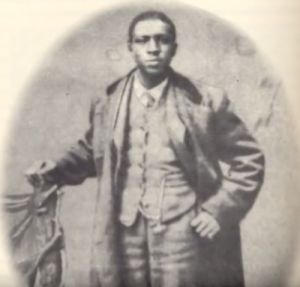
King Kelly
(December 31, 1857 – November 8, 1894),
Also commonly known as “$10,000 Kelly“, was an American outfielder, catcher, and manager in various professional American baseball leagues including the National League, International Association, Players’ League, and the American Association. He spent the majority of his 16-season playing career with the Chicago White Stockings and the Boston Beaneaters. Kelly was a player-manager three times in his career – in 1887 for the Beaneaters, in 1890 leading the Boston Reds to the pennant in the only season of the Players’ League’s existence, and in 1891 for the Cincinnati Kelly’s Killers – before his retirement in 1893. He is also often credited with helping to popularize various strategies as a player such as the hit and run, the hook slide, and the catcher’s practice of backing up first base. In 1945, Kelly was elected to the Baseball Hall of Fame.
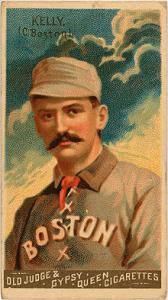
In concluding where to truly give Kelly credit as an innovator, a 2004 book devoted to 19th-century rule bending in baseball—and which came close to exhaustively accounting for all contemporary reporting on various subjects—placed stress on the following: “Kelly’s hook slide does sound special, and players probably tried to copy it. Also, he seems to have been the first big leaguer to successfully cut a base (when the usually lone umpire wasn’t looking), at least according to the newspaper record.” And, “Kelly could have been the first to foul off lots of pitches on purpose. Doing so was a top trick of some Baltimore players of the 1890s. At the turn of the century, that trick was defused when all foul balls began counting as strikes.”
Kelly’s autobiography Play Ball: Stories of the Ball Field (1889) was published while he was with the Beaneaters in 1888, the first autobiography by a baseball player; it was ghostwritten by Boston baseball writer John J. “Jack” Drohan. Kelly also became a vaudeville performer during his playing career, first performing in Boston where he would recite the now-famous baseball poem “Casey at the Bat“, sometimes butchering it. Kelly’s baserunning innovations are also the subject of the hit 1889 song entitled “Slide, Kelly, Slide” and a 1927 comedy film of the same name.
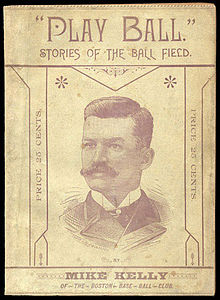
Ned Williamson
(October 24, 1857 – March 3, 1894)
He was an American professional baseball infielder in Major League Baseball. He played for three teams: the Indianapolis Blues of the National League (NL) for one season, the Chicago White Stockings (NL) for 11 seasons, and the Chicago Pirates of the Players’ League for one season.
From 1883 and 1887, Williamson held the single-season record for both doubles and home runs. Although his record for doubles was surpassed in 1887, he held the home run record until 1919, when it was topped by Babe Ruth of the Boston Red Sox. Statistically, he was one of the best fielders of his era. During the first eight years of his career, he led the league at his position in both fielding percentage and double plays five times, and he also led his position in assists six times. Later, when he moved to shortstop, he again led the league in both assists and double plays.
His career was shortened by a knee injury that he suffered in Paris during a world-tour organized by Albert Spalding. After he left organized baseball, his health declined rapidly. He contracted tuberculosis and ultimately died at the age of 36 of dropsy.

Bud Fowler
(March 16, 1858 – February 26, 1913)
Born “John W. Jackson“, He was an American baseball player, manager, and club organizer. He is the earliest known African-American player in organized professional baseball. He was elected to the Baseball Hall of Fame in 2022.
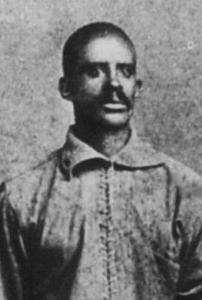
John L. Sullivan
(October 15, 1858 – February 2, 1918),
Known simply as John L. among his admirers, and dubbed the “Boston Strong Boy” by the press, was an American boxer. He is recognized as the first heavyweight champion of gloved boxing, de facto reigning from February 7, 1882, to September 7, 1892. He is also generally recognized as the last heavyweight champion of bare-knuckle boxing under the London Prize Ring Rules, being a cultural icon of the late 19th century America, arguably the first boxing superstar and one of the world’s highest-paid athletes of his era. Newspapers’ coverage of his career, with the latest accounts of his championship fights often appearing in the headlines, and as cover stories, gave birth to sports journalism in the United States and set the pattern internationally for covering boxing events in media, and photodocumenting the prizefights.
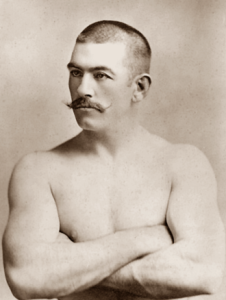
Walter Camp
(April 7, 1859 – March 14, 1925)
He was an American college football player and coach, and sports writer known as the “Father of American Football”. Among a long list of inventions, he created the sport’s line of scrimmage and the system of downs. Camp was one of the most accomplished persons in the early history of American football. He attended Yale College, where he played and coached college football. Camp’s Yale teams of 1888, 1891, and 1892 have been recognized as national champions. Camp was inducted into the College Football Hall of Fame as a coach during 1951.
Camp wrote articles and books on the gridiron and sports in general, annually publishing an “All-American” team. By the time of his death, he had written nearly 30 books and more than 250 magazine articles.
The annual Walter Camp Award is named in his honor, recognizing the best all-around collegiate football player.
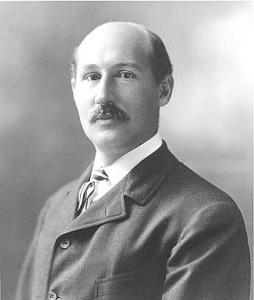
Born in 1860’s
Modern Tennis Inventor’s Brother
Eugenius Harvey Outerbridge
(March 8, 1860 – November 10, 1932)
He was a businessman and promoter of patent fiberboard, and the first chairman of the interstate agency known then as the Port of New York Authority. The Outerbridge Crossing, a Port Authority bridge, was named for him.
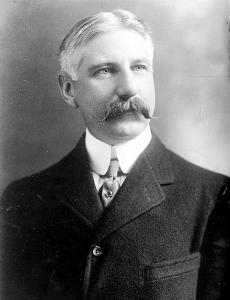
Eugenius sister was
Mary Ewing Outerbridge,
(February 16, 1852 – May 3, 1886)
She was the founder, in 1874, of American lawn tennis which was the progenitor of modern.
James Naismith,
(November 6, 1861 – November 28, 1939)
He was a Canadian-American physical educator, physician, Christian chaplain, and sports coach, best known as the inventor of the game of basketball.
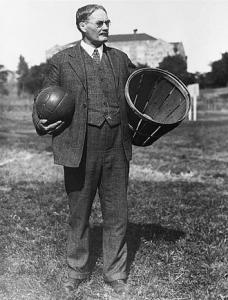
Pierre de Coubertin
(January 1, 1863 –September 2, 1937)
He was a French educator and historian, co-founder of the International Olympic Committee (IOC), and its second president. He is known as the father of the modern Olympic Games. He was particularly active in promoting the introduction of sport in French schools.
Born into a French aristocratic family, Coubertin became an academic and studied a broad range of topics, most notably education and history. He graduated with a degree in law and public affairs from the Institut d’études politiques de Paris (Sciences Po). It was at the Institut d’études politiques de Paris that he came up with the idea of reviving the Olympic Games.
The Pierre de Coubertin World Trophy and the Pierre de Coubertin Medal are named in his honour.
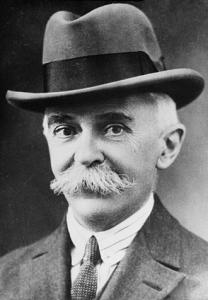
Blanche Bingley Hillyard
(November 3, 1863 –August 6, 1946)
She was an English tennis player. She won six singles Wimbledon championships (1886, 1889, 1894, 1897, 1898, 1900) and was runner up seven times, having also competed in the first ever Wimbledon championships for women in 1884.
She also won the Irish Championships three times (1888, 1894, 1897); the German International Championships twice (1897, 1900); and the South of England Championships at Eastbourne, 11 times between 1885 and 1905.

Albert Lemaître
(c. 1864 – in or after 1906)
Also known as Georges Lemaître was a French sporting motorist and early racing driver. He was the first petrol powered finisher in what is described as ‘the world’s first competitive motoring event’ when he drove his Peugeot Type 7 from Paris to Rouen at 19 km/h (12 mph) in 1894. The Comte de Dion had finished first but his steam-powered vehicle was ineligible for the main prize which was shared between the manufacturers Peugeot and Panhard.
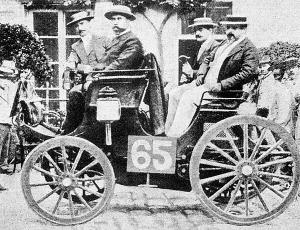
E. P. Taylor ‘s Parents
Geni – Plunket Bourchier Taylor (1864-1944)
+ Florence Gertrude Taylor (Magee)
= E. P. Taylor CMG
(January 29, 1901 – May 14, 1989)
He was a Canadian business tycoon, investor and philanthropist. He was a famous breeder of Thoroughbred race horses, and a major force behind the evolution of the Canadian horse-racing industry. Known to his friends as “Eddie”, he is all but universally recorded as “E. P. Taylor”.
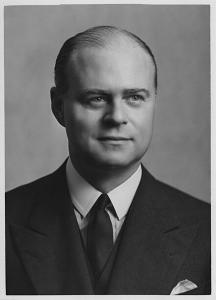
James John Corbett
(September 1, 1866 – February 18, 1933)
He was an American professional boxer and a World Heavyweight Champion, best known as the only man who ever defeated John L. Sullivan (hence the “man who beat the man” concept of the championship boxing lineage). Despite a career spanning only 20 bouts, Corbett faced the best competition his era had to offer, squaring off with a total of nine fighters who would later be enshrined alongside him in the International Boxing Hall of Fame.

Cy Young
(March 29, 1867 – November 4, 1955)
He was an American Major League Baseball (MLB) pitcher. Born in Gilmore, Ohio, he worked on his family’s farm as a youth before starting his professional baseball career. Young entered the major leagues in 1890 with the National League‘s Cleveland Spiders and pitched for them until 1898. He was then transferred to the St. Louis Cardinals franchise. In 1901, Young jumped to the American League and played for the Boston Red Sox franchise until 1908, helping them win the 1903 World Series. He finished his career with the Cleveland Naps and Boston Rustlers, retiring in 1911.
Young was elected to the National Baseball Hall of Fame in 1937. He is often regarded as one of the greatest pitchers of all time, as well as a pioneer of modern pitching. In 1956, one year after his death, the Cy Young Award was created to annually honor the best pitcher in the Major Leagues (later each League) of the previous season, cementing his name as synonymous with excellence in pitching.
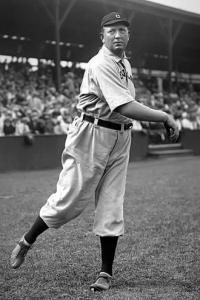
Born in 1870’s
William G. Morgan,
(January 23, 1870 – December 27, 1942)
He was the inventor of volleyball, originally called “Mintonette”, a name derived from the game of badminton which he later agreed to change to better reflect the nature of the sport.
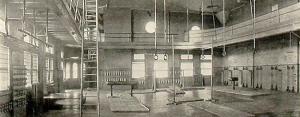
Doc Powers
(September 22, 1870 – April 26, 1909)
He was an American Major League Baseball player who caught for four teams from 1898 to 1909.
Powers played for the Louisville Colonels and Washington Senators of the National League, and the Philadelphia Athletics and New York Highlanders of the American League.
He played college baseball at College of the Holy Cross and at the University of Notre Dame in 1897 and 1898.
Powers’ nickname was derived honestly from the fact he was a licensed physician as well as a ballplayer. During a brief stint with the New York Highlanders in 1905, Powers caught while Jim “Doc” Newton pitched, creating the only known example of a two-physician battery in Major League history.
On April 12, 1909, Powers was injured during the first game played in Philadelphia’s Shibe Park, crashing into a wall while chasing a foul pop-up. He sustained internal injuries from the collision and died two weeks later from complications from three intestinal surgeries, becoming possibly the first Major Leaguer to suffer an on-field injury that eventually led to his death. The immediate cause of death was peritonitis arising from post-surgery infections.
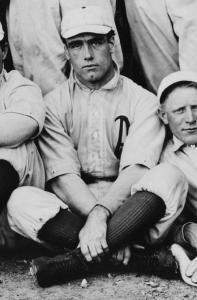
Gilbert Fuchs
(1871–1952)
He was a German figure skater who won the first World Figure Skating Championships, held in St. Petersburg, Russia, in 1896. He recaptured the world title ten years later in Munich.

Maurice Garin
(March 3, 1871 – February 19, 1957)
He was an Italian-French road bicycle racer best known for winning the inaugural Tour de France in 1903, and for being stripped of his title in the second Tour in 1904 along with eight others, for cheating. He was of Italian origin but adopted French nationality on December 21, 1901.
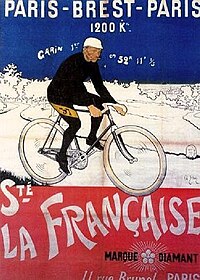
Jonah Kūhiō Kalanianaʻole
(March 26, 1871 – January 7, 1922)
He was a prince of the Kingdom of Hawaiʻi until it was overthrown by a coalition of American and European businessmen in 1893. He later went on to become a representative in the Territory of Hawaii as delegate to the United States Congress, and as such is the only royal-born member of Congress.
Kūhiō was often called Ke Aliʻi Makaʻāinana (Prince of the People) and is well known for his efforts to preserve and strengthen the Hawaiian people.
While attending school in San Mateo, Kūhiō and his brothers surfed the Pacific seashore at Santa Cruz. The brothers demonstrated the Hawaiian sport of board surfing to the locals, becoming the first California surfers in 1885. In September 1890, Kawānanakoa and Kūhiō became the first surfers in the British Isles and taught their English tutor John Wrightson (1840 – 30 November 30, 1916) to surf on the beaches of Bridlington in northern England.
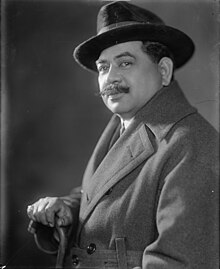
Lottie Dod
(September 24, 1871 – June 27, 1960)
She was an English multi-sport athlete, best known as a tennis player. She won the Wimbledon Ladies’ Singles Championship five times, the first one when she was only 15 in the summer of 1887. She remains the youngest ladies’ singles champion.

Louis Sockalexis
(October 24, 1871 – December 24, 1913)
Nicknamed the Deerfoot of the Diamond, he was an American baseball player. Sockalexis played professional baseball in the National League for three seasons, spending his entire career (1897–1899) as an outfielder for the Cleveland Spiders. A Penobscot, Sockalexis is often identified as the first person of Native American ancestry to play in the National League and Major League Baseball.
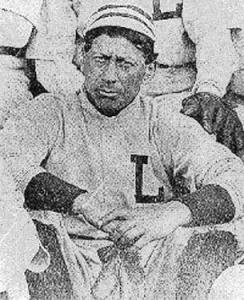
Aristides (horse)
(1872–1893)
The Horse was an American Thoroughbred racehorse that won the first Kentucky Derby in 1875.

Spyridon Louis
(January 12, 1873 –March 26, 1940),
Commonly known as Spyros Louis (Σπύρος Λούης), was a Greek water carrier who won the first modern-day Olympic marathon at the 1896 Summer Olympics. Following his victory, he was celebrated as a national hero
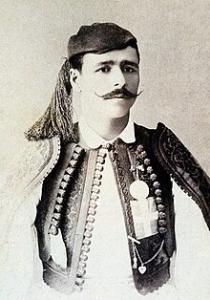
Honus Wagner
(February 24, 1874 – December 6, 1955),
HE was an American baseball shortstop who played 21 seasons in Major League Baseball from 1897 to 1917, almost entirely for the Pittsburgh Pirates. Wagner won his eighth (and final) batting title in 1911, a National League record that remains unbroken to this day, and matched only once, in 1997, by Tony Gwynn.
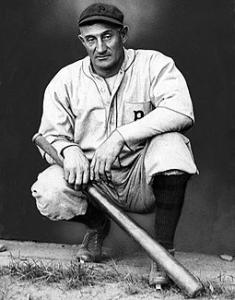
James J. Jeffries
(April 15, 1875 – March 3, 1953)
He was an American professional boxer and world heavyweight champion.
He was known for his enormous strength and stamina. Using a technique taught to him by his trainer, former welterweight and middleweight Champion Tommy Ryan, Jeffries fought out of a crouch with his left arm extended forward. He was able to absorb tremendous punishment while wearing his opponents down.
Jeffries stood 6 ft 1.5 in (1.87 m) tall and weighed 225 pounds (102 kg) in his prime. He could run 100 yards (91 m) in just over ten seconds, and could high jump over 6 feet (180 cm). A natural left-hander, he possessed one-punch knockout power in his left hook, and brawled his way to the top of the rankings.
Writer Jack London coined the phrase “Great White Hope” to describe Jeffries in his attempt to win the heavyweight crown from African-American world champion Jack Johnson in 1910. Jeffries came out of retirement for the fight, urged on by London and many others who wished to see a white man once again reign as heavyweight champion. Jeffries was beaten by Johnson in what was the first prizefight to be billed as the “Fight of the Century“.
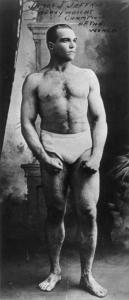
Karl Hovelsen
(March 23, 1877 – September 13, 1955)
He was a Norwegian Nordic skier. Howelsen Hill Ski Area in Steamboat Springs, Colorado was named in his honor.
Howelsen Hill is the oldest ski resort in the United States and the oldest continually operating ski area in North America! It has quite a reputation in the professional skiing community, producing over 100 Olympians, 22 Colorado Ski Hall of Famers, and 13 National Ski Hall of Fame inductees.
It sits deep within the Yampa Valley, nestled next to Steamboat Springs, Colorado. Howelsen Hill is owned and operated by the city, but unlike the previous mountain on this list, Howelsen is open to the public.
It was initially known as Elk Park before being renamed Howelsen Hill in 1917, after the resort’s creator Karl Hovelsen. Initially, it was a training ground for ski jumpers but was expanded in 1931 to include the alpine skiing area.
The portion of the mountain dedicated to ski jumping holds some truly massive jumps that have produced two world records that still stand today. Ragnar Omtvedt and Henry Hall landed 192.9ft and 203ft, respectively, off the famous HS127 ski jump.

Frank Gotch
(April 27, 1877 – December 17, 1917)
He was an American professional wrestler. Gotch was the first American professional wrestler to win the world heavyweight free-style championship, and he is credited for popularizing professional wrestling in the United States.
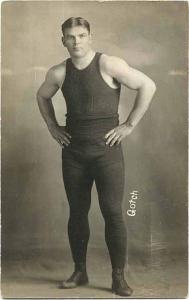
Jack Johnson (boxer)
(March 31, 1878 – June 10, 1946)
Nicknamed the “Galveston Giant“, he was an American boxer who, at the height of the Jim Crow era, became the first black world heavyweight boxing champion (1908–1915). His 1910 fight against James J. Jeffries was dubbed the “fight of the century”. Johnson defeated Jeffries, who was white, triggering dozens of race riots across the U.S. According to filmmaker Ken Burns, “for more than thirteen years, Jack Johnson was the most famous and the most notorious African American on Earth”. He is widely regarded as one of the most influential boxers in history. Transcending boxing, he became part of the culture and history of racism in the United States.
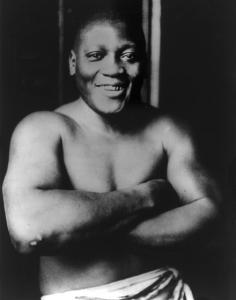
George Hackenschmidt
(August 1, 1878– February 19, 1968)
He was an Estonian strongman, professional wrestler, writer, and sports philosopher who is recognized as professional wrestling’s first world heavyweight champion.
Hackenschmidt began his professional career in Tallinn (Reval), Estonia (then part of the Russian Empire) and lived most of his life in London, England, where he was nicknamed “The Russian Lion”. He is believed to be the creator of the professional wrestling version of the bear hug as well as the person who popularised the hack squat; additionally, Hackenschmidt is also attributed as the creator of the bench press. He was known for his impressive strength, fitness, and flexibility. Later in life, he wrote many books on physical culture, training and philosophy.
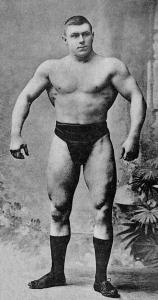
Born in 1880’s
Christy Mathewson
(August 12, 1880 – October 7, 1925)
Nicknamed “Big Six“, “the Christian Gentleman“, “Matty“, and “the Gentleman’s Hurler“, was an American Major League Baseball right-handed pitcher, who played 17 seasons with the New York Giants. He stood 6 ft 1 in (1.85 m) tall and weighed 195 pounds (88 kg). He was among the most dominant pitchers in baseball history, and ranks in the all-time top 10 in several key pitching categories, including wins, shutouts, and earned run average. In 1936, Mathewson was elected into the Baseball Hall of Fame as one of its first five members.
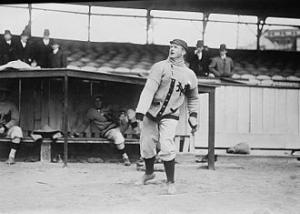
Jimmy Winkfield
April 12, c. 1880–1882– March 23, 1974)
He was a Thoroughbred jockey and horse trainer from Kentucky, best remembered as the last African American to ride a winner in the Kentucky Derby (1902).
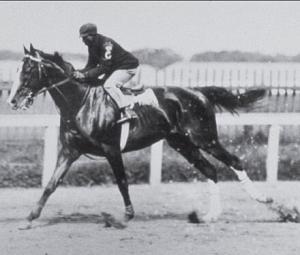
Rafael Gómez Ortega
(1882 – 1960)
Also known as El Gallo (“the rooster“) he was an early twentieth century bullfighter. He came from a family of famous bullfighters, including his matador father, Fernando Gómez García and matador younger brother, José Gómez Ortega. He is today remembered for several of his unique fighting techniques such as the espantada – or “sudden flight”, which simply consisted of him fleeing when the bull entered the ring. Other techniques included fighting bulls from a chair
His fights were considered amusing to audiences, and he was brought out of retirement seven times because of this “sportsmanship”. He finally retired on October 4, 1936. Commentators find that his intermittent fear of the bulls was characteristic of his style, noting that he was often brave when it suited him, and gave in to panic when it did not.
Ortega later wasted his fortune, and was supported by Juan Belmonte. He was briefly married to Pastora Imperio, a famous flamenco dancer.
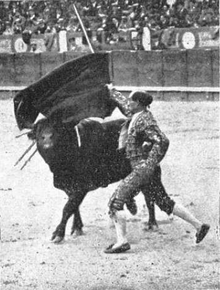
Jess McMahon
(October 29, 1882 – November 21, 1954)
He was an American professional wrestling and professional boxing promoter, and patriarch of the McMahon family, founders of Capitol Wrestling Corporation, precursor to the present-day WWE.
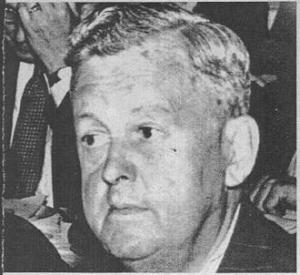
John Taylor (relay runner)
(November 3, 1882, – December 2, 1908)
He was an American track and field athlete, notable as the first African American to win an Olympic gold medal.
Less than five months after returning from the Olympic Games in London, Taylor died of typhoid fever on 2 December 1908 at the age of 26. He is interred at Eden Cemetery in Collingdale, Pennsylvania.
In his obituary, The New York Times called him “the world’s greatest negro runner.” In a letter to Taylor’s parents, Harry Porter, fellow Irish American Athletic Club member and acting President of the 1908 U.S. Olympic Team wrote:
It is far more as the man (than the athlete) that John Taylor made his mark. Quite unostentatious, genial, (and) kindly, the fleet-footed, far-famed athlete was beloved wherever known…As a beacon of his race, his example of achievement in athletics, scholarship and manhood will never wane, if indeed it is not destined to form with that of Booker T. Washington.
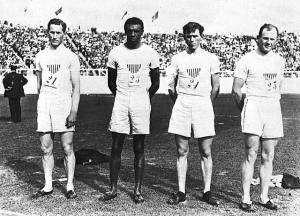
Bradbury Robinson,
(February 1, 1884 – March 7, 1949)
American football player, who threw the first forward pass in American football history.
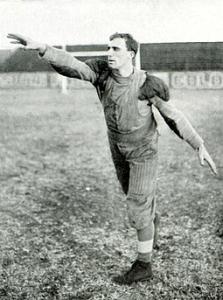
Dorando Pietri
(October 16, 1885 – February 7, 1942)
He was an Italian long-distance runner. He finished first in the marathon at the 1908 Summer Olympics in London but was subsequently disqualified.
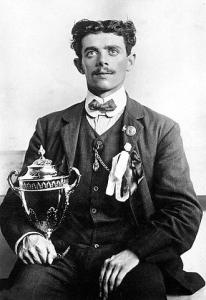
Ehrhardt Koch
(1886–1954)
was a German American businessman and founder of the New Era Cap Company.
Koch’s only son, Harold, took over from his father as head of the firm and established the company’s ties to Major League Baseball beginning in the 1950s. Koch died in 1954 at age 68. His company is still family owned today.
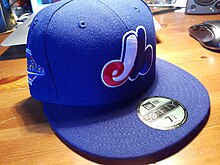
Ty Cobb
(December 18, 1886 – July 17, 1961),
Nicknamed “the Georgia Peach“, was an American professional baseball center fielder. Cobb is credited with setting 900 MLB records throughout his career. Cobb has won more batting titles than any other player, with 11 (or 12, depending on source).
Cobb’s legacy, which includes a large college scholarship fund for Georgia residents financed by his early investments in Coca-Cola and General Motors, has been somewhat tarnished by allegations of racism and violence. These primarily stem from a couple of mostly discredited biographies that were released following his death. Cobb’s reputation as a violent man was exaggerated by his first biographer, sportswriter Al Stump, whose stories about Cobb have been proven as sensationalized and largely fictional.[17][18][19][20] While he was known for often violent conflicts, he spoke favorably about black players joining the Major Leagues and was a well-known philanthropist.
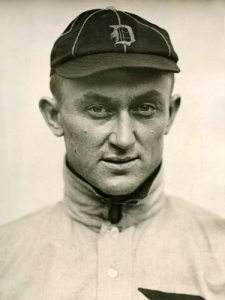
Grover Cleveland Alexander
(February 26, 1887 – November 4, 1950)
Nicknamed “Old Pete” and “Alexander the Great“, was an American Major League Baseball pitcher. He played from 1911 through 1930 for the Philadelphia Phillies, Chicago Cubs, and St. Louis Cardinals. He was elected into the Baseball Hall of Fame in 1938.
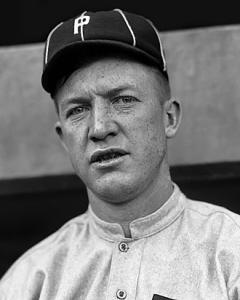
Jim Thorpe,
(May 22 or 28, 1887 – March 28, 1953)
He was an American athlete and Olympic gold medalist. A member of the Sac and Fox Nation, Thorpe was the first Native American to win a gold medal for the United States in the Olympics. Considered one of the most versatile athletes of modern sports, he won two Olympic gold medals in the 1912 Summer Olympics (one in classic pentathlon and the other in decathlon). He also played football (collegiate and professional), professional baseball, and professional basketball.
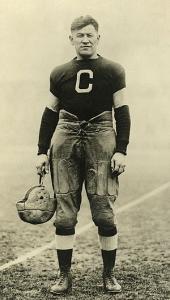
Shoeless Joe Jackson
(July 16, 1887 – December 5, 1951)
He was an American outfielder who played Major League Baseball (MLB) in the early 20th century. Although his .356 career batting average is the fourth highest in the history of Major League Baseball (MLB), he is often remembered for his association with the Black Sox Scandal, in which members of the 1919 Chicago White Sox participated in a conspiracy to fix the World Series. As a result, Commissioner Kenesaw Mountain Landis banned Jackson from baseball after the 1920 season. During the World Series in question, Jackson had led both teams in several statistical categories and set a World Series record with 12 base hits. Jackson’s role in the scandal, banishment from the game, and exclusion from the Baseball Hall of Fame have been fiercely debated.
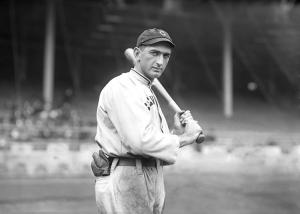
Grandma Gatewood
Emma Rowena Gatewood
(October 25, 1887 – June 4, 1973)
She was an American ultra-light hiking pioneer. After a difficult life as a farm wife, mother of eleven children, and survivor of domestic violence, she became famous as the first solo female thru-hiker of the 2,168-mile (3,489 km) Appalachian Trail (A.T.) in 1955 at the age of 67. She subsequently became the first person (male or female) to hike the A.T. three times, after completing a second thru-hike two years later, followed by a section-hike in 1964. In the meantime, she hiked 2,000 miles (3,200 km) of the Oregon Trail in 1959. In her later years, she continued to travel and hike, and worked on a section of what would become the Buckeye Trail. The media coverage surrounding her feats was credited for generating interest in maintaining the A.T. and in hiking generally. Among many other honors, she was posthumously inducted into the Appalachian Trail Hall of Fame in 2012.
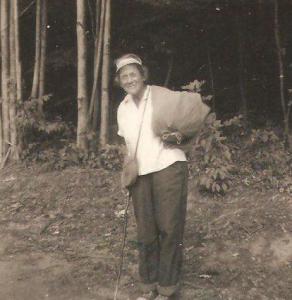
Walter Johnson
(November 6, 1887 – December 10, 1946)
Nicknamed “Barney” and “the Big Train“, was an American professional baseball player and manager. He played his entire 21-year baseball career in Major League Baseball as a right-handed pitcher for the Washington Senators from 1907 to 1927. He later served as manager of the Senators from 1929 through 1932 and of the Cleveland Indians from 1933 through 1935.
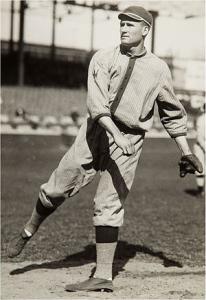
Knute Rockne, All American
(March 4, 1888 – March 31, 1931)
He was an American football player and coach at the University of Notre Dame. Leading Notre Dame for 13 seasons, Rockne accumulated over 100 wins and three national championships.
Rockne is regarded as one of the greatest coaches in college football history. His biography at the College Football Hall of Fame, where he was inducted in 1951, identifies him as “without question, American football’s most-renowned coach”. Rockne helped to popularize the forward pass and made the Notre Dame Fighting Irish a major factor in college football.
In 1931, at the age of 43, Rockne died in a plane crash.
